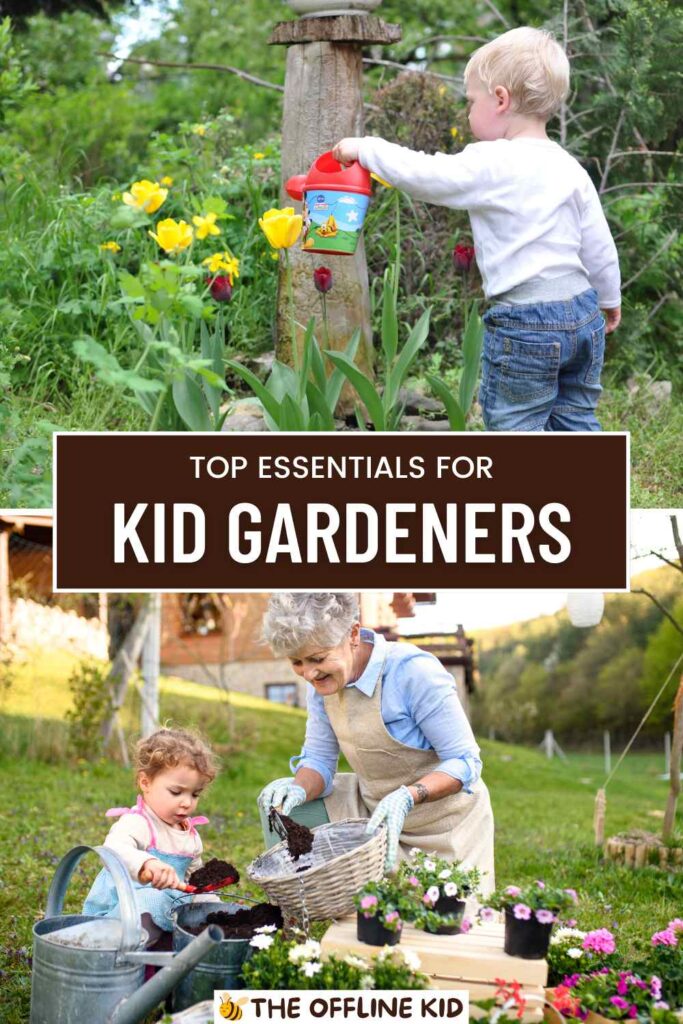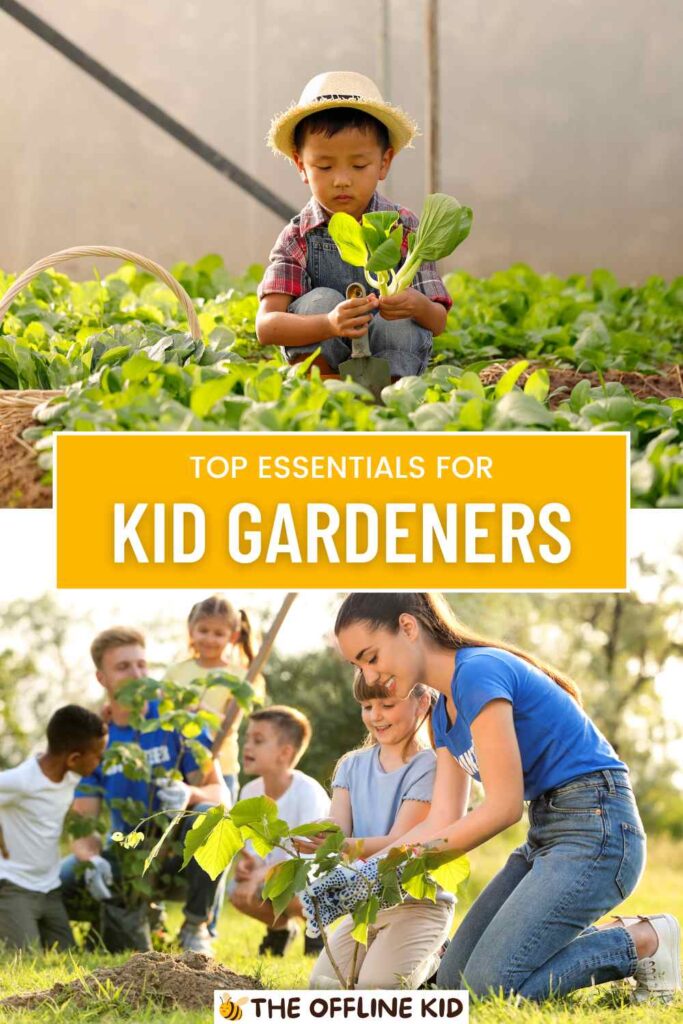Gardening is a fantastic way to teach children about nature, patience, and responsibility while letting them get their hands dirty in the most delightful way.
In this guide, we’ll cover all the essential tips, tools, and activities to help you and your kids cultivate a thriving garden together.
Tools and Equipment
Providing children with the right gardening essentials for kids is the first step to spark curiosity and ensure safety.
With appropriate tools, your young gardener can explore, dig, plant, and water without frustration or injury. Equipping them with child-friendly versions of basic garden tools allows them to learn confidently.
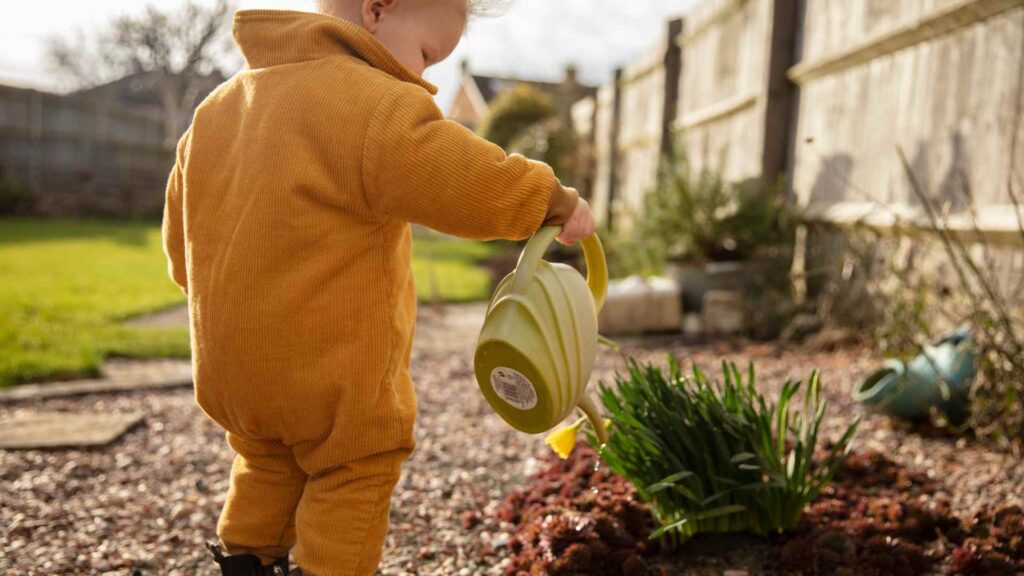
- Child-Sized Tools
- Spade or Shovel: Look for a lightweight shovel with a shorter handle that kids can easily grip.
- Trowel: A smaller, handheld version for digging small holes or transplanting seedlings.
- Rake: Choose one with rounded edges and a comfortable handle to make raking leaves safe and fun.
- Personal Gear
- Gardening Gloves: Protect little hands from thorns, insects, or dirt. Colorful designs and proper fit encourage kids to wear them.
- Sun Hat: Safeguard sensitive skin and eyes from direct sunlight with a brimmed hat.
- Apron or Overalls: Keep clothes clean and add a sense of “official” gardening duty.
- Watering Tools
- Watering Can: A lightweight can or bucket helps children master the art of gentle watering.
- Sprayer or Hose Attachment: For older kids, a low-pressure sprayer can be fun and effective.
In addition to tools, make sure to include items that foster a child’s sense of wonder and creativity, such as magnifying glasses for bug-watching, plant markers they can decorate, and small buckets for collecting treasures.
Teaching children how to properly store and clean their tools after each gardening session is equally essential. Not only does it instill responsibility, but it also makes future gardening adventures easier to start.
Encourage kids to personalize their gear by painting their names on handles or choosing bright colors. This ownership helps them see gardening as their project, sparking enthusiasm to explore more.
When selecting tools, focus on quality and safety first. Well-made, child-friendly equipment lasts longer and reduces the risk of accidents.
By ensuring that your little ones have the right implements, you’re laying a solid foundation for their gardening experience. With the correct tools at hand, kids can begin learning the importance of stewardship, responsibility, and confidence in the garden—one spadeful of soil at a time.
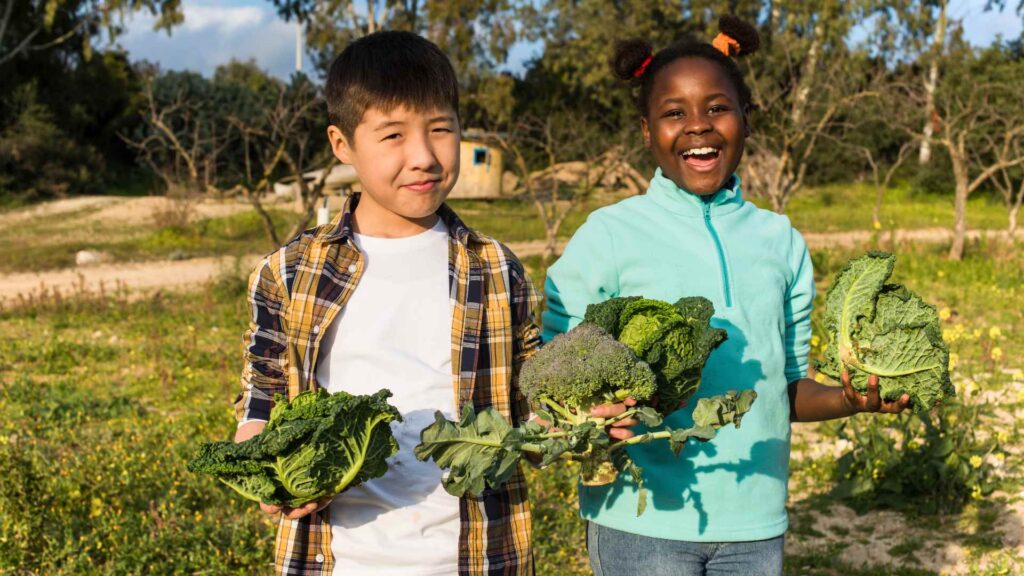
Soil Preparation
Soil preparation is a vital part of gardening essentials for kids, introducing them to fundamental lessons about plant health and growth.
Children will learn about soil composition, nutrient balance, and the importance of a thriving ecosystem beneath their feet. This is a fantastic opportunity to show how science plays a role in gardening success.
- Understanding Soil Types
- Clay Soil: Often heavy and dense; it can hold nutrients well but needs aeration.
- Sandy Soil: Quick-draining and loose, making it easier for roots to spread but prone to nutrient loss.
- Loamy Soil: A balanced mix of sand, silt, and clay—often considered ideal for most plants.
- Soil Testing
- pH Level: Teach kids how to use simple test strips or a DIY kit. They’ll see how soil acidity or alkalinity affects plant health.
- Nutrient Content: Show them basic tests or visual cues—like yellow leaves or weak stems—that indicate a lack of essential nutrients.
- Conditioning the Soil
- Adding Compost: Enrich soil with organic matter to introduce beneficial microbes and improve texture.
- Mulching: Use leaves, straw, or wood chips on top of the soil to help retain moisture and regulate temperature.
- Fertilizing: Opt for gentle, natural fertilizers (e.g., fish emulsion, worm castings) to keep chemical use low.
The process of digging, turning, and amending soil can be an exciting hands-on science lesson. Children will enjoy the sensory experience: the feel of crumbly loam, the sight of hidden earthworms, and the smell of fresh, earthy compost. Encourage them to observe how insects and worms help aerate the soil and break down organic matter.
To engage kids further, you can set up a compost bin or worm farm. They’ll learn how kitchen scraps and yard waste transform into nutrient-rich compost. This not only reduces household waste but also fosters an eco-friendly mindset. Teach them that healthy soil is the foundation of a thriving garden, and caring for it means caring for the plants, insects, and environment around them.
Proper soil preparation sets the stage for robust plant growth and teaches children that the unseen elements often play the most significant role. By investing time in soil preparation, you’re teaching kids that gardening success depends on laying the proper groundwork—literally. These lessons of patience and nurturing will follow them long after they leave the garden bed behind.
Selecting the Right Plants
Choosing suitable seeds and seedlings is a core component of gardening essentials for kids, ensuring early success and sparking ongoing interest. Plant selection doesn’t have to be complicated; starting with easy-to-grow varieties helps build confidence and keeps children excited. They’ll learn about climate, plant characteristics, and the joys of seeing quick results.
- Beginner-Friendly Options
- Sunflowers: Fast-growing, tall, and vibrant—children love measuring their height.
- Beans: Germinate quickly and grow visibly, allowing kids to track progress daily.
- Radishes: Have a short growing cycle, letting children see results in just a few weeks.
- Herbs and Edibles
- Basil: Grows easily in pots or garden beds; great for teaching about harvest and flavor.
- Mint: Hardy and aromatic—kids enjoy the scent and the refreshing taste.
- Cherry Tomatoes: Sweet and rewarding, perfect for snacking straight off the vine.
- Flowers
- Marigolds: Bright, hardy, and beneficial for pest control.
- Zinnias: Offer an array of colors and are relatively low-maintenance.
- Nasturtiums: Edible flowers that add flavor to salads and color to garden beds.
When selecting plants, consider factors like the local climate, amount of sunlight, and the space available. Include your children in this decision-making process, having them research or observe what grows best in your region. Show them seed packets or plant tags to interpret key details such as sunlight requirements, spacing, and water needs.
Encourage curiosity by letting your kids pick out something unusual or experimental. This might be a funky-colored carrot variety, a miniature pumpkin, or a striped tomato. By allowing them to explore new plants, you foster a sense of adventure and broaden their palates.
A successful plant selection process also emphasizes biodiversity. Explain how different species attract pollinators or repel harmful insects. Adding pollinator-friendly plants—like lavender or coneflowers—can transform your garden into a mini wildlife haven. Teach kids that each plant plays a role in the bigger picture of the garden’s ecosystem, cultivating respect for all living things.
Involving your children in plant selection not only instills decision-making skills, it also bridges the gap between healthy eating habits and an appreciation for nature. By nurturing a wide variety of plants, you’ll cultivate curiosity, patience, and a lasting love for the outdoors.
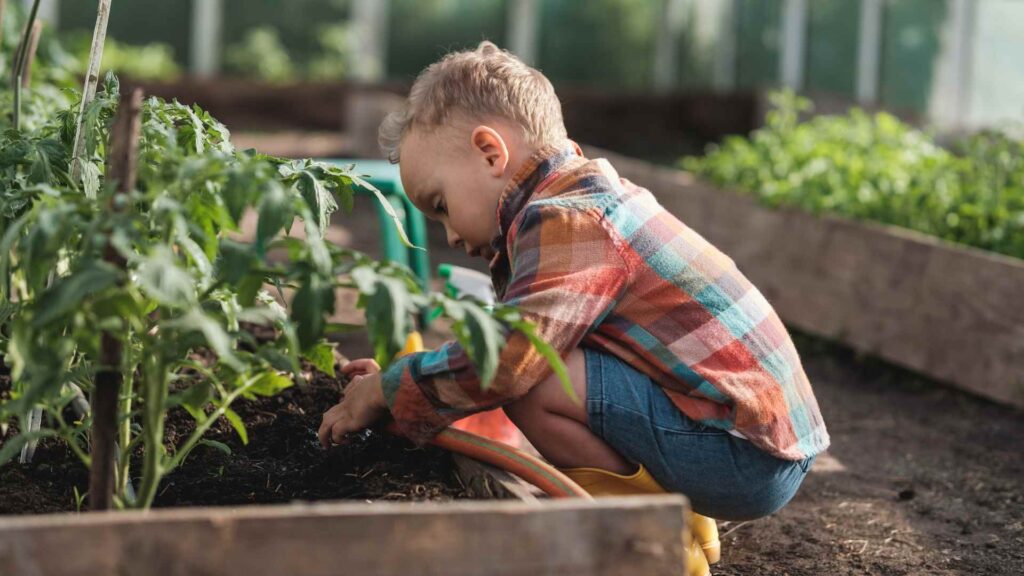
Planting Seeds and Seedlings
The act of planting seeds and seedlings is where the rubber meets the road in gardening essentials for kids.
It’s the transition from planning to action—a chance for children to see tangible progress in their work. With gentle guidance and fun techniques, planting can become an exciting adventure that sets the stage for future growth.
- Seed Starting Basics
- Indoor Seed Trays: Ideal for cooler climates or earlier starts. Children can monitor sprouting day by day.
- Seed Depth: Teach kids to read instructions on seed packets; planting too deep or too shallow affects growth.
- Watering Routine: Light misting keeps seeds moist without drowning them.
- Transplanting Seedlings
- Timing: Wait until the last frost date has passed before moving tender seedlings outdoors.
- Hardening Off: Gradually introduce seedlings to outdoor conditions. Start with a few hours of sunlight per day, then slowly increase exposure.
- Handling Roots: Show children how delicate roots can be. Encourage them to gently loosen the root ball before placing it into the soil.
- Direct Sowing
- Easy Crops: Beans, peas, and radishes often perform well when sown directly into the garden.
- Spacing: Use a ruler or stick to measure distance between seeds, making the planting process both precise and playful.
- Fun with Rows: Invite children to create neat rows or shapes with their seeds, turning the garden into a living art project.
Throughout the planting process, emphasize the importance of patience and respect for nature. Kids learn that each seed holds tremendous potential, but requires the right conditions—sunlight, water, and nutrient-rich soil—to thrive. You can spark their sense of wonder by letting them peel back the soil gently to observe how roots develop over time.
Labeling is another valuable lesson. Have kids make creative plant markers—using popsicle sticks, painted rocks, or colorful labels—so they can easily track each plant’s progress. This small task can reinforce reading, writing, and organizational skills in a real-life setting.
Planting seeds and seedlings is more than just burying a seed in the ground; it’s a lesson in responsibility, nurturing, and anticipation. Kids delight in watching those first tiny leaves emerge, discovering that their careful effort leads to vibrant life. This moment of planting is the heart of gardening, a hands-on experience that cultivates patience, resilience, and a deeper connection to the natural world.
Watering and Maintenance
Once seeds and seedlings are tucked into the earth, the focus shifts to watering and maintenance—crucial components of gardening essentials for kids.
Regular care ensures that young plants remain healthy and robust, giving children firsthand experience with responsibility and routine. Through thoughtful guidance, kids will learn how to observe plant needs and respond accordingly.
- Watering Techniques
- Consistency: Water at the same time each day to create a dependable routine.
- Amount of Water: Teach kids the “finger test”—if the top inch of soil is dry, it’s time to water.
- Watering Can vs. Hose: Smaller children may prefer a small watering can for precision, while older ones can help with a hose on a gentle setting.
- Weeding and Mulching
- Identifying Weeds: Show children how to recognize and remove unwanted plants that compete for nutrients.
- Proper Technique: Teach them to pull weeds at the root to prevent regrowth.
- Mulch Benefits: Spread mulch around plants to reduce weed growth and retain soil moisture.
- Routine Checks
- Pest Control: Promptly address any pests—like aphids or caterpillars—using natural solutions when possible (e.g., handpicking or introducing beneficial insects like ladybugs).
- Pruning and Pinching: Demonstrate how removing dead leaves or spent flowers encourages healthier growth.
- Plant Health Observations: Encourage children to examine leaves, stems, and buds for any signs of stress or disease.
Children flourish when they see direct connections between their actions and positive outcomes. Let them measure how high the plants have grown after consistent watering or note the number of blooms on a well-maintained flower. These simple observations solidify the idea that their care directly affects living things.
In addition, daily or weekly garden “check-ups” provide an excellent time to bond and chat about progress, challenges, or potential improvements. This interactive nature of gardening builds problem-solving skills and fosters resilience, as kids learn to adapt their methods when faced with unexpected hurdles like inclement weather or pests.
Balance fun with responsibility by reminding children that plants depend on them for survival. The joy of seeing a plant bounce back after a thorough watering or weed removal helps establish a profound sense of accomplishment. By engaging them in routine maintenance, you lay the groundwork for strong work ethics, a deeper connection to nature, and a willingness to care for living things—qualities that will serve them well in every aspect of life.
Creative and Educational Activities
Gardening is a treasure trove of imaginative play and learning—an integral part of gardening essentials for kids.
Beyond simply planting and watering, you can incorporate creative projects and educational experiments that make the garden a living classroom. These hands-on activities can spark curiosity, deepen understanding, and make gardening an endless adventure.
- Art in the Garden
- Nature Collages: Collect leaves, petals, and twigs to create collages or artwork.
- Painted Rocks: Decorate stones as garden markers or fun critters.
- DIY Birdhouses: Craft birdhouses or feeders to encourage avian visitors and teach kids about garden ecology.
- Science Experiments
- Seed Germination Jars: Grow seeds in clear jars with damp paper towels to observe root and shoot development.
- Pollination Demonstration: Use a small brush to transfer pollen from one flower to another, illustrating how pollinators help plants.
- Soil Erosion Test: Compare how water flows through bare soil vs. mulch-covered soil, teaching kids about conservation.
- Garden Journals
- Daily Observations: Encourage children to record plant growth, weather changes, and new discoveries.
- Drawings and Diagrams: Let them illustrate their plants at different stages, reinforcing botanical knowledge.
- Reflecting on Experiences: Add notes on what worked well, what failed, and ideas for the next season.
- Harvest Celebrations
- Garden-to-Table Cooking: Involve kids in simple recipes—like salads or herb-infused drinks—that use freshly picked produce.
- Taste Tests: Compare store-bought produce with homegrown goodies, highlighting flavor differences.
- Family Picnics: Set up a small table in the garden to share a meal and admire the results of collective effort.
By weaving artistic and scientific activities into your garden routine, you keep kids excited and engaged. These activities offer a deeper perspective on the interconnectedness of soil, plants, insects, and even the weather. Children become more observant, learning to spot changes—like a sudden bloom or a swarm of beneficial ladybugs—as signs of a living ecosystem.
Such immersive experiences encourage creativity, critical thinking, and environmental stewardship. Kids might design their own miniature fairy garden or conduct a ladybug watch to see which plants attract beneficial bugs. Each activity not only entertains but also enlightens, reinforcing that the garden is more than just a place to plant seeds—it’s a window into the wonders of nature.
Incorporating creative and educational projects helps transform a backyard into a dynamic learning landscape. By merging fun with knowledge, you cultivate a lifelong passion for gardening and a genuine respect for the environment, all wrapped in the warm memory of shared, hands-on discovery.
Organic and Eco-Friendly Practices
Teaching children about sustainable gardening is one of the most valuable lessons in gardening essentials for kids.
An eco-friendly approach not only improves plant health but also protects local ecosystems and wildlife. By introducing organic methods early on, you’ll help cultivate mindful, environmentally-conscious gardeners who value harmony with nature.
- Natural Pest Control
- Beneficial Insects: Encourage ladybugs, lacewings, and praying mantises to keep pest populations in check.
- Companion Planting: Place complementary plants—like marigolds near tomatoes—to repel pests naturally.
- Handpicking Pests: Show kids how to gently remove slugs or caterpillars by hand, an effective and chemical-free method.
- Chemical-Free Fertilizers
- Homemade Compost: Teach children to recycle kitchen scraps, yard clippings, and paper waste into rich compost.
- Compost Tea: Steep compost in water to create a nutrient-rich “tea” for boosting plant growth.
- Worm Castings: Set up a simple worm bin; kids love feeding scraps to worms and using their castings as plant food.
- Water Conservation
- Rain Barrels: Collect rainwater for garden use, demonstrating efficient resource management.
- Drip Irrigation: Show kids how a slow, steady water supply reduces evaporation and waste.
- Mulching: Retains moisture and lessens the need for frequent watering.
- Pollinator-Friendly Planting
- Native Flowers: Opt for local species that bees and butterflies recognize as nectar sources.
- Avoid Pesticides: Teach kids how harmful chemicals can affect bees, birds, and other important pollinators.
- Habitat Creation: Build small brush piles or set up bee hotels to shelter beneficial insects.
Instilling a love for the environment through gardening goes beyond just teaching children how to grow plants. It includes discussions about why it’s important to protect pollinators, reduce chemical usage, and conserve water. Kids quickly learn that the actions they take can either harm or heal the world around them.
Planting native species or focusing on heirloom seeds can introduce the concept of biodiversity, showing children how diverse plant varieties support a richer web of life. Encourage them to keep a lookout for birds, bees, or butterflies visiting the garden. Each creature that stops by presents a real-life lesson on symbiosis and the delicate balance of nature.
Fostering eco-friendly practices in kids equips them with respect for the planet. As they watch their gardens thrive without synthetic chemicals, they witness the power of nature’s own cycles and processes.
This hands-on understanding of sustainability can spark environmental stewardship that resonates beyond the garden gates—empowering them to be thoughtful caretakers of the Earth for years to come.
Harvesting and Enjoying the Fruits of Their Labor
Reaping the rewards of hard work is the final, joyous step in gardening essentials for kids. After weeks or months of tending, the garden comes to life with ripe fruits, vibrant vegetables, and colorful flowers.
Harvesting not only offers tangible results but also reinforces essential lessons about patience, responsibility, and gratitude.
- Harvest Timing
- Visual Cues: Show kids how to identify when produce is ready—like a bright color or a firm texture.
- Taste Tests: If it’s safe, pick a sample to taste test for sweetness or ripeness.
- Continuous Harvesting: Some crops, like lettuce or beans, keep producing if you harvest regularly.
- Proper Technique
- Gentle Picking: Use two hands to avoid damaging plants. One hand to hold the stem, the other to remove the fruit or vegetable.
- Tools: Scissors or pruners help cleanly cut off produce and reduce stress on the plant.
- Storage: Teach kids to sort freshly harvested items according to whether they need refrigeration or can remain at room temperature.
- Sharing and Community
- Family Meals: Incorporate fresh harvests into daily cooking; children love eating what they’ve grown.
- Donations: Encourage kids to share surplus produce with neighbors or local food banks, fostering kindness and empathy.
- Seed Saving: Demonstrate how to collect seeds from mature plants for next season’s garden.
- Celebration
- Garden Parties: Host a small gathering to showcase the garden’s bounty.
- Photo Journals: Capture “before and after” pictures, highlighting growth and transformation.
- Gratitude: Remind children to appreciate the soil, sun, and water that made their harvest possible.
Through harvesting, children gain a profound sense of accomplishment. They see firsthand the results of their diligence and nurture—turning tiny seeds into nourishing produce or spectacular blooms. This moment becomes a springboard for discussions about nutrition, self-sufficiency, and community. Kids learn that healthy eating can be fun and deeply rewarding when they’ve had a hand in growing the food themselves.
Encourage them to experiment in the kitchen with simple recipes that use their homegrown fruits, veggies, or herbs. Whether it’s a refreshing mint lemonade or a fresh tomato pasta sauce, these culinary adventures fortify the link between field and fork. With each bite, children taste the fruits of their labor, reinforcing the powerful lesson that good things truly take time, effort, and care.
Harvesting is the natural conclusion to months of gardening effort, but it also signals a new beginning—preparing the garden for the next growing season or exploring new plants to cultivate.
In this cycle of planting, nurturing, harvesting, and replanting, children see life’s continuous rhythm. They end the season with a sense of pride and a deeper bond with the natural world, ready and eager to grow again.
Conclusion
Gardening with kids is more than just planting seeds; it’s about tending to growth, nurturing curiosity, and celebrating successes.
Embrace every moment—from planning and planting to harvesting and sharing. By cultivating enthusiasm now, you’ll empower children to carry a lifelong appreciation for nature and healthy living into the future.
